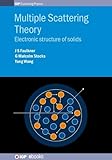Multiple scattering theory : electronic structure of solids / J.S. Faulkner, G. Malcolm Stocks, Yang Wang.
Material type: TextSeries: IOP (Series)Release 6 | IOP expanding physicsPublisher: Bristol [England] (Temple Circus, Temple Way, Bristol BS1 6HG, UK) : IOP Publishing, [2018]Description: 1 online resource (various pagings) : illustrations (some color)Content type: text Media type: electronic Carrier type: online resourceISBN: 9780750314909 ebookOther title: Electronic structure of solidsSubject(s): Multiple scattering (Physics) | Energy-band theory of solids | Materials / States of matter | SCIENCE / Physics / ElectromagnetismAdditional physical formats: Print version:: No titleDDC classification: 530.4/16 LOC classification: QC173.4.M85 F386 2018ebOnline resources: e-book Full-text access Also available in print.
TextSeries: IOP (Series)Release 6 | IOP expanding physicsPublisher: Bristol [England] (Temple Circus, Temple Way, Bristol BS1 6HG, UK) : IOP Publishing, [2018]Description: 1 online resource (various pagings) : illustrations (some color)Content type: text Media type: electronic Carrier type: online resourceISBN: 9780750314909 ebookOther title: Electronic structure of solidsSubject(s): Multiple scattering (Physics) | Energy-band theory of solids | Materials / States of matter | SCIENCE / Physics / ElectromagnetismAdditional physical formats: Print version:: No titleDDC classification: 530.4/16 LOC classification: QC173.4.M85 F386 2018ebOnline resources: e-book Full-text access Also available in print.| Item type | Current library | Collection | Call number | Copy number | Status | Date due | Barcode |
|---|---|---|---|---|---|---|---|
| E-Books | MEF eKitap Kütüphanesi | IOP Science eBook - EBA | QC173.4.M85 F386 2018eb (Browse shelf (Opens below)) | Available | IOP_20210098 |
Browsing MEF eKitap Kütüphanesi shelves Close shelf browser (Hides shelf browser)

|

|

|

|

|

|

|
||
| QC171.2 .F675 2019eb Lectures on the physics of extreme states of matter / | QC173 .C653 2019eb Atomic and molecular physics : a primer / | QC173 .W556 2018eb The molecule as meme / | QC173.4.M85 F386 2018eb Multiple scattering theory : electronic structure of solids / | QC173.458.S62 M658 2018eb Ultrasound-mediated imaging of soft materials / | QC173.59.S65 D537 2019eb Special and general relativity : an introduction to spacetime and gravitation / | QC173.6 .R646 2019eb On the principle of holographic scaling : from college physics to black hole thermodynamics / |
"Version: 20181201"--Title page verso.
Includes bibliographical references.
1. History of multiple scattering theory -- 2. Scattering theory -- 2.1. Potential scattering -- 2.2. Position representation -- 2.3. The classic scattering experiment -- 2.4. Angular momentum expansion -- 2.5. Non-spherical potentials with fini
3. Multiple scattering equations -- 3.1. Derivation of multiple scattering equations -- 3.2. Approximations -- 3.3. Proof of Korringa's hypothesis -- 3.4. The Korringa-Kohn-Rostoker band theory -- 3.5. Constant energy surfaces -- 3.6. Space-fill
4. Green's functions -- 4.1. The free-particle Green's functions and its adjoint -- 4.2. The Green's function for one scatterer -- 4.3. The Green's function for N scatterers -- 4.4. The Green's function for an infinite periodic lattice -- 4.5. T
5. MST for systems with no long range order -- 5.1. The supercell method -- 5.2. An order-N method for large systems -- 5.3. Magnetism -- 5.4. The coherent potential approximation for random alloys -- 5.5. The spectral density function -- 5.6. R
6. Spectral theory in multiple scattering theory -- 6.1. Krein's theorem -- 6.2. Calculations with real potentials using Krein's theorem -- 6.3. Lloyd's formula and Krein's theorem
7. Toy models -- 7.1. The Kronig-Penney model -- 7.2. The transfer matrix approach -- 7.3. The MST approach -- 7.4. The Kronig-Penney model of a disordered alloy -- 7.5. The average trace method -- 7.6. The coherent potential approximation -- 7.
8. Relativistic full potential MST calculations -- 8.1. The Dirac equation -- 8.2. Relativistic Green's function -- 8.3. Some examples
9. Applications of MST -- 9.1. Incommensurate concentration waves -- 9.2. Correlations and order in alloy concentrations -- 9.3. The embedded cluster Monte-Carlo method -- 9.4. High entropy alloys -- 10. Conclusions : beautiful minds.
In 1947, it was discovered that multiple scattering theory can be used to solve the Schr�odinger equation for the stationary states of electrons in a solid. Written by experts in the field, Dr. J S Faulkner, G M Stocks, and Yang Wang, this b
Also available in print.
Mode of access: World Wide Web.
System requirements: Adobe Acrobat Reader, EPUB reader, or Kindle reader.
Professor John Samuel Faulkner obtained his PhD in physics from The Ohio State University, and is currently professor emeritus of Florida Atlantic University. Professor Faulkner has celebrated a career in physics for over five decades and has nu
Title from PDF title page (viewed on January 16, 2019).
